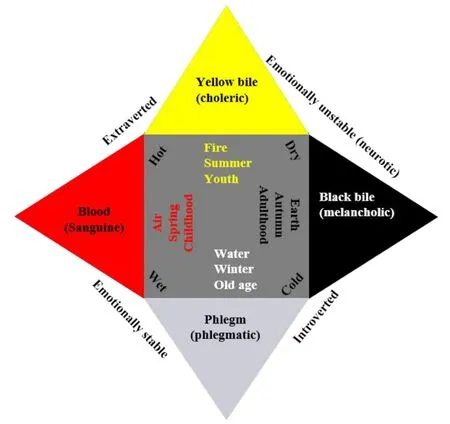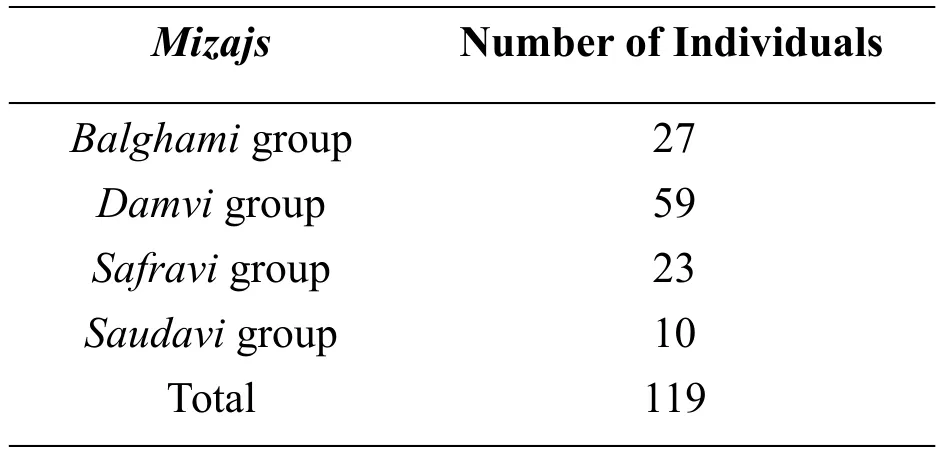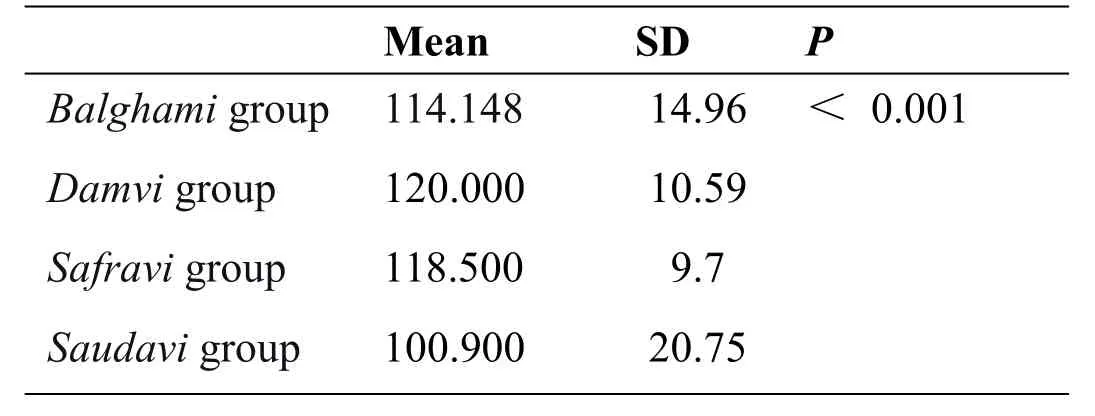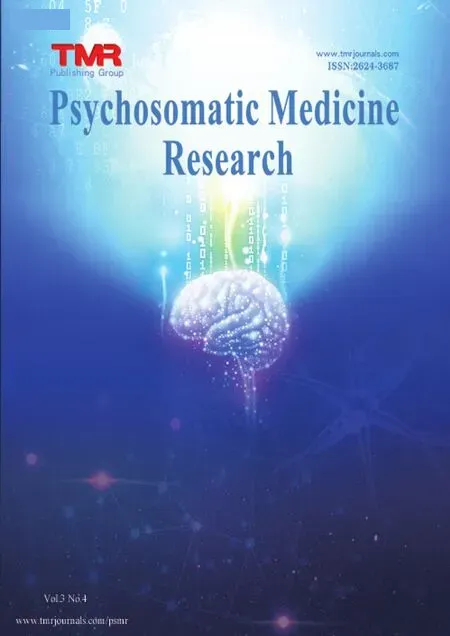An Assessment of the Relationship Between Mizaj and Happiness in College Students During and After Complete Lockdown
Iqra Hashmi*,Yusuf JamalDepartment of physiology,Ayurvedic and Unani Tibbia College,Karol Bagh,Delhi-05,India.
Abstract
Unani medicine(also called as Greco-Arab medicine)is an ancient system of medicine that originated in Greece.The Mizaj(temperament)is one of the fundamental concepts of the Unani system of medicine,diagnosis,and management of a disease.Every human being has been furnished with a specific Mizaj through which the organs and systems of an individual perform their functions properly.This study assessed the relationship between Mizaj-dependent qualities and happiness symptomatology in college students before and after a lockdown.A cross-sectional descriptive study to assess the Mizaj and happiness index—with the help of the Mizaj assessment proforma based on classical literature and an Oxford Happiness Questionnaire—in 119 college students of different genders was performed.The findings of this study suggest that restrictions influence the happiness index of daily life.However,the impact of restrictions to go out and to follow a daily routine(on the happiness index)in the Damvi,Safravi,and the Balghami group appears to be more critical compared with that of the Saudavi group participants.
Keywords:Oxford Happiness Questionnaire,Damvi,Saudavi,Balghami,Safravi,Mizaj
Background
The Unani system describes seven essential components of the body, which are calledUmoor-e-tabiya(namely,Arkanor elements).These elements comprise earth,water,air,and fire as different states of matter and the building blocks of everything in the universe:Mizaj(temperament),Akhlat(humor),Aza(organs),Arwaah(life,spirit,or vital breath),Quwa(energy),andAfa’al(action)[1].
Hippocrates(460 B.C.),an Unani physician,presents the doctrine of body fluids(i.e.,HumorsorAkhlat,[singular khilt])in his book “Human Nature.”He maintains that the human body contains four major kinds of humor—i.e.,Dam(blood),Balgham(Phlegm),Safra(yellow bile),andSauda(black bile;Figure 1).According to quality and quantity,an accurate proportion and mixing of these elements(homeostasis)constitutes health.However,inaccurate proportion and irregular distribution,according to their quantity and quality,constitute disease.Thus,this humoral theory states that if homeostasis is maintained inside the body the person will remain healthy,and if this homeostasis is disturbed,then the disease will develop.This aligns with the law of treatment in the Unani system of medicine.Hence,this hemostasis ofAkhlatdeals with every aspect of disease(i.e.,etiology,pathology,prevention,and treatment)[3].Internal and external causes influence the hemostasis of the human body leading tosu’Mizajthat ultimately inflict the whole body or a specific organ in the form of the disease.The principle of management of the disease is to correct the alteredMizaj.Thus,before commencing any treatment,theMizajof a patient or organ must be evaluated[4].
Mizajidentification indices are very diverse and are divided into ten groups(10 criteria)for ease of use.These criteria include the state of the skin(touch),hair,soft tissue,skin color,body dimensions(physique),physical and physiological functions,quality of waste matter(stool,urine,and sweat),sleep and wakefulness,impressibility speed,and psychic function[5].One of the factors present in the index of“psychic function”is happiness.The majority of references to Persian medicine(PM)mention it as important in theMizajdiagnosis index[6].
The level of happiness is expected to decrease on the basis of the level of coldness,and it is expected to increase on the basis of the level of the warmness ofMizaj.Nevertheless,in cases of abnormal warmness,the level of happiness will decrease[7].
One study was done in PM to assess the correlation between happiness andMizajof university students[8]showed that there is a certain relationship betweenMizajand happiness.Even after a thorough review of literature,we didn’t find enough articles related and due to lack of related data in the literature,this study was conducted to assess the correlation betweenMizaj-dependent qualities and happiness symptomatology most during Covid 19 lockdown and social distancing restrictions.If a meaningful relationship is found,happiness can be introduced as one of the practical indices for designing and validating the diagnostic scales ofMizajand the clinical applications ofMizajidentification.

Figure 1 Distribution of Mizaj and their qualities
Methods
Respondents
The participants were screened according to the following inclusion criteria:individuals of 18–30 years of age,either gender,clinically healthy individuals,and students who were implementing social restrictions and blockades during a lockdown and participated in(and completed)the study during and after a lockdown.Additionally,the exclusion criteria of subjects were as follows:alcoholics,smokers,or tobacco users;pregnancy and lactation;history of trauma;and students who were not implementing social restrictions and did not participate in(and complete)the study during and after lockdown.
Research methods
Questionnaire design
There are two questionnaires in this study.Questionnaire one is for the assessment ofMizaj—i.e.,Damvi(Sanguineous),Safravi(Bilious),Balghami(Phlegmatic),andSaudavi(Melancholic).This is based onAjnas e Ashraor the 10 classical parameters:Malmas(Tactus);Lahm-wa-Shahm(flesh and fats);Ashaar(hair rate of growth,color,and distribution);Laun-e-Badan(body complexion);Hayyat-e-Aza(physique),Kaifiat-e-Infaal(responsiveness of organs),Afal-e-Aza(state of functions);Fuzlaat-e-Badan(body waste);Nom-wa-Yaqza(sleep and wakefulness);andInfalat-e-Nafsaniya(psychic reactions).These parameters are described in the Unani classical literature and generated by the Central Council for Research in Unani Medicine,Ministry of AYUSH,New Delhi.The participants responded to the questionnaire according to their characteristics,and their scores were calculated.
Oxford Happiness Questionnaire(OHQ) was developed by psychologists Michael Argyle and Peter Hills at Oxford University.OHQ comprises29 questions with a six-point Likert scale that evaluates life satisfaction,self-esteem,subjective well-being,self-satisfaction,and positive mood.The reliability of the questionnaire—Hindi version on Indian—was checked using Cronbach’s alpha(0.82),and it was subsequently deemed acceptable and reliable[9].
Sampling method
Using simple random sampling in Delhi(India)119 college students from the Ayurvedic and Unani Tibbia College and Hospital,Karol Bagh,were selected and asked to complete the questionnaire.The data collection process started on March 2,2020 and ended on August 17,2020 for the lockdown period.The participants were adequately informed about all relevant aspects of the survey,including the objective and interview procedures.All participants voluntarily participated in the survey,and the survey was anonymous.
Investigation methods
The study was conducted through one-by-one inquiry by individually providing subjects the questionnaire via email and performing a video call during the blockade and a video call(or email)following the blockade.To ensure the authenticity and effectiveness of the outcome,only one proforma ofMizajand OHQ,along with informed consent,was provided to participants.All of the questions raised by participants were answered by the investigator without interference.
Statistical methods
SPSS statistics software 22.0 was used to establish a database for statistical description.The two-way analysis of variance test in SPSS was used to analyze the differences between the groups;P<0.05 suggested that the difference was statistically significant.
Consent of participants
All of the participants provided their consent to participate in the study.Additionally,all of the participants were provided with information regarding research ethics,and they subsequently signed a consent form after being fully apprised of the aim of the study,the advantage of participation,and their ability to withdraw from participation.Identifiable personal information was deliberately deleted during the transcription process and was recorded on the questionnaires’transcripts only as ID numbers.
Data collection
A total of 130 volunteers were randomly selected forMizajidentification and the determination of the happiness index.Of these volunteers,11 individuals did not respond to the questionnaire according to the requirement,therefore,those volunteers were excluded from the study,leaving a remaining 119 subjects.
Results
Out of the 119 participants,44.54% were female and 55.46% were male.The majority of the 59 participants comprisedDamvi Mizaj(49.58%),27 comprisedBalghami Mizaj(22.69%),23 composedSafravi Mizaj(19.33%),and 10 comprisedSaudavi(8.40%)(Table 1).This is based on the score calculated byMizajassessment proforma described in Unani classical literature.Undergraduate students and unmarried students accounted for the largest proportions of the sample.

Table 1 Distribution of participants with different Mizajes
According to Table 2,the OHQ score inDamvi Mizajgroup(M=120.00),followed by theSafravi Mizaj group(M=118.500),were significantly higher than theBalghamigroup(M=114.148),followed by theSaudavi Mizajgroup(M=100.900)(p<0.001).

Table 2 OHQ score for different Mizaj
According to Table 3,participants from theBalghamigroup during complete lockdown(M=102.222,SD=18.74)were significantly unhappier than after the lockdown(M= 126.07,SD=18.74),participants in theDamvigroup during the lockdown(M=109.44,SD=12.5)were also significantly unhappier than after the lockdown(M=130.55,SD=8.6),and participants in theSafravigroup were also significantly unhappier during the lockdown(M=106.91,SD=10.60)than after the lockdown(M=130.08,SD=8.80).However,the participants from theSaudavigroup were significantly happier during the lockdown(M= 107.10,SD=29.5)than after the lockdown(M=94.70,SD=12.00),P<0.001.

Table 3 Two way ANOVA for OHQ score for different Mizaj
These findings suggest that restrictions influence the happiness index of daily life.However,the impact of restrictions on the happiness index—to go out and to follow a daily routine—in theDamvi,Safravi,andBalghamigroups,appears to be more critical compared with that of the participants in theSaudavigroup.
Discussion
Mark and Holder(2011)assessed the correlation between temperament and happiness in 311 children aged 9–12 years and suggested that being physically and socially active,less shy,and excited are indices that increase happiness among participants[10].This research aligns with the perspectives of the Unani scholars.Ibn Sinain “Canon of Medicine,”suggests thatsinne namuis a stage of life that is valid up to the age of 30 years.It is believed that this stage is typified by theMizajbeing hot because of more innate heat,and subsequently,this increased heat results in an increase in energy for physical activity[11].Physical activity is vital in mental satisfaction and happiness.Our findings also suggest that restrictions that limit interaction with the outside world mostly affected theBalghami,DamviandSafravigroups.
Thomas et al.(2016)studied the correlation between personality and happiness and demonstrated that optimism,self-confidence,and self-esteem increase happiness[12].These personality traits also indicate the warmness ofMizajbased on theoretical principles of Unani medicine[5].These results support our findings that theDamviandSafravi Mizajparticipants appear more self-confident and happier after the removal of lockdown restrictions.People with hot temperaments have more energy for physical activity[11].
Our study revealed that there is a positive correlation between happiness and warmness and a negative correlation between happiness and coldness ofMizaj.
This study has the following limitations:female participants were more prevalent in the sample size than male participants,the sample size was small,the assessment ofMizajwas based on the subjective parameters—as defined by ancient Unani Physicians,and the happiness index was calculated using the OHQ.Thus,this study cannot be generalized to the whole population.Further study must be conducted with a large sample size to acquire a better understanding of the correlation of happiness withMizaj.
Conclusion
Based on our results,we found that the Oxford happiness index is highest in people with DamviMizajand lowest in those with SaudaviMizaj.This is in accordance with the experimental hypothesis of this research work.From this study,it is clear that there is a possible correlation between the Oxford happiness index andMizaj.Consequently,happiness could be considered as one of the diagnostic indices of temperament.
 Psychosomatic Medicine Resesrch2021年4期
Psychosomatic Medicine Resesrch2021年4期
- Psychosomatic Medicine Resesrch的其它文章
- Advances in the Pathogenesis of Vascular Cognitive Impairment
- A Commentary of the Queer People of Color Identity Affirmation Scale for Positive Attitudes
- Left Temporal Lobe Arachnoid Cyst Presenting with Symptoms of Psychosis
- Intervention Study on Hypnotherapy of Primary Dysmenorrhea in Female College Students
- Analysis of the Influence of the Self-efficacy of College Students on Their Response Behaviors Toward COVID-19
